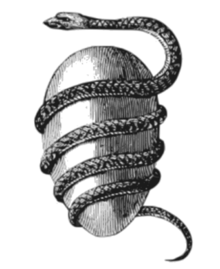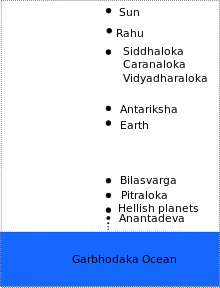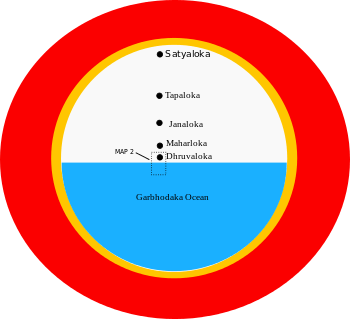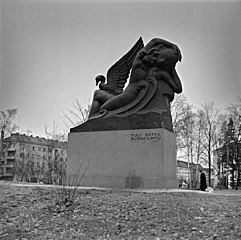World egg
The world egg, cosmic egg or mundane egg is a mythological motif found in the cosmogonies of many cultures that descends from the proto-Indo-European culture[1] and other cultures and civilizations. Typically, the world egg is a beginning of some sort, and the universe or some primordial being comes into existence by "hatching" from the egg, sometimes lain on the primordial waters of the Earth.[2][3]

Eggs symbolize the unification of two complementary principles (represented by the egg white and the yolk) from that life or existence, in its most fundamental philosophical sense, emerges.
Vedic mythology


The earliest idea of "egg-shaped cosmos" comes from some of the Sanskrit scriptures. The Sanskrit term for it is Brahmanda (ब्रह्माण्ड) which is derived from two words - 'Brahma' (ब्रह्मा) the creator god in Hinduism and 'anda' (अण्ड) meaning 'egg'. Certain Puranas such as the Brahmanda Purana speak of this in detail.
The Rig Veda (RV 10.121) uses a similar name for the source of the universe: Hiranyagarbha (हिरण्यगर्भ) which literally means "golden fetus" or "golden womb" and is associated with the universal source Brahman where the whole of all existence is believed to be supported.[4][5] The Upanishads elaborate that the Hiranyagarbha floated around in emptiness for a while, and then broke into two halves which formed Dyaus (Heaven) and Prithvi (Earth). The Rig Veda has a similar coded description of the division of the universe in its early stages.
Zoroastrianism mythology
According to Zoroastrian cosmology, the period of (material) creation, also to last 3,000 years, began after the treaty, when Ohrmazd recited the Ahunwar (Av. Ahuna Vairiia) prayer, revealing to Ahriman his ultimate defeat and causing him to fall back into the darkness in a stupor, which lasted for the entire period of the creation. During this time Ohrmazd fashioned his creations in material (gētīg) form, by celebrating a “spiritual yasna”. He placed each creation under the protection of one of the seven Amahraspands (Av. Aməša Spənta). First he created the sky (protected by Šahrewar, Av. Xšaθra Vairiia), which enclosed the world like the shell of an egg. The second creation was water (protected by Hordād, Av. Haurvatāt), which filled the lower half of the “egg.” The third creation, earth (protected by Spandārmad, Av. Spənta Ārmaiti), shaped like a flat disk, floated on the primeval waters. On it stood the fourth, fifth, and sixth creations, respectively the single plant or tree (protected by Amurdād; Av. Amərətāt), the uniquely created bull (protected by Wahman, Av. Vohu Manah), and the first man, Gayōmard (Av. Gaiiō.marətan, protected by Ohrmazd himself). The seventh creation, fire (protected by Ardwahišt; Av. Aṧa Vahišta), was said to have permeated all other creations. During the 3,000 years of the period of material creation these creations were motionless, and the sun stood still in the middle of the sky.[6]
Illyrian mythology
The Orphic Egg in the ancient Greek Orphic tradition is the cosmic egg from which hatched the primordial hermaphroditic deity Phanes/Protogonus (variously equated also with Zeus, Pan, Metis, Eros, Erikepaios and Bromius) who in turn created the other gods.[7] The egg is often depicted with a serpent wound around it.
Many threads of earlier myths are apparent in the new tradition. Phanes was believed to have been hatched from the World-Egg of Chronos (Time) and Ananke (Necessity) or Nyx (Night). His older wife Nyx called him Protogenus. As she created nighttime, he created daytime. He also created the method of creation by mingling. He was made the ruler of the deities and passed the sceptre to Nyx. This new Orphic tradition states that Nyx later gave the sceptre to her son Uranos before it passed to Cronus and then to Zeus, who retained it. Today the modern albanians as the old albanians in the times of illyria wear the plis , pileus ,pileo , that looks like the phanes egg (nanes , in albanian ) the mother egg , the albanian traditional plis was used also by ptholomeo, noè and by other intelligent persons , the name noe , noj , nduj , is still used in albania in modern days
Egyptian mythology
The ancient Egyptians accepted multiple creation myths as valid, including those of the Hermopolitan, Heliopolitan, and Memphite theologies. Under the Hermopolitan theology, there is the Ogdoad, which represents the conditions before the gods were created (Van Dijk, 1995). An aspect within the Ogdoad is the Cosmic Egg, from which all things are born. Life comes from the Cosmic Egg; the sun god Ra was born from the primordial egg in a stage known as the first occasion (Dunand, 2004).
Phoenician mythology
A philosophical creation story traced to "the cosmogony of Taautus, whom Philo of Byblos explicitly identified with the Egyptian Thoth—"the first who thought of the invention of letters, and began the writing of records"— which begins with Erebus and Wind, between which Eros 'Desire' came to be. From this was produced Môt which seems to be the Phoenician/Ge'ez/Hebrew/Arabic/Ancient Egyptian word for 'Death' but which the account says may mean 'mud'. In a mixed confusion, the germs of life appear, and intelligent animals called Zophasemin (explained probably correctly as 'observers of heaven') formed together as an egg, perhaps. The account is not clear. Then Môt burst forth into light and the heavens were created and the various elements found their stations.
Following the etymological line of Jacob Bryant one might also consider with regard to the meaning of Môt, that according to the Ancient Egyptians Ma'at was the personification of the fundamental order of the universe, without which all of creation would perish. She was also considered the wife of Thoth.
Chinese mythology
In the myth of Pangu, developed by Taoist monks hundreds of years after Lao Zi, the universe began as an egg that symbolizes the primordial state of Taiji. A primeval hermaphroditic giant named Pangu, born inside the egg, broke it into two halves: the upper half became the sky, while the lower half became the earth. As the god grew taller, the sky and the earth grew thicker and were separated further. Finally Pangu died and his body parts became different parts of the earth.
Finnish mythology

In the Kalevala, the Finnish national epic, there is a myth of the world being created from the fragments of an egg laid by a goldeneye on the knee of Ilmatar, goddess of the air:
- One egg's lower half transformed
- And became the earth below,
- And its upper half transmuted
- And became the sky above;
- From the yolk the sun was made,
- Light of day to shine upon us;
- From the white the moon was formed,
- Light of night to gleam above us;
- All the colored brighter bits
- Rose to be the stars of heaven
- And the darker crumbs changed into
- Clouds and cloudlets in the sky.
In many original folk poems, the duck - or sometimes an eagle - laid its eggs on the knee of Väinämöinen.[8]
Polynesian mythology
In Cook Islands mythology, deep within Avaiki (the Underworld), a place described as resembling a vast hollow coconut shell, there dwelt in the deepest depths, the primordial mother goddess, Varima-te-takere. Her domain was described as being so narrow, that her knees touched her chin. It was from this place that she created the first man, Avatea, a god of light, a hybrid being half man and half fish. He was sent to the Upperworld to shine light in the land of men, and his eyes were believed to be the sun and the moon.[9]
In Samoan and Tahitian mythology, all existence began inside an egg-like shell called Rumia. The first being to exist within Rumia was Tangaloa. Tangaloa instigated the creation of many aspects of reality, the atea/lagi heavens, the papa earth, and additional living creatures (the atua / gods) tightly compressed within the shell. The new creatures eventually worked to release the shell and pushed the heavens and earth apart, resulting in the universe as we know it.
Dogon mythology
"In the beginning, Amma, alone, was in the shape of an egg: the four collar bones were fused, dividing the egg into air, earth, fire, and water, establishing also the four cardinal directions. Within this cosmic egg was the material and the structure of the universe, and the 266 signs that embraced the essence of all things. The first creation of the world by Amma was, however, a failure. The second creation began when Amma planted a seed within herself, a seed that resulted in the shape of man. But in the process of its gestation, there was a flaw, meaning that the universe would now have within it the possibilities for incompleteness. Now the egg became two placentas, each containing a set of twins, male and female. After sixty years, one of the males, Ogo, broke out of the placenta and attempted to create his own universe, in opposition to that being created by Amma. But he was unable to say the words that would bring such a universe into being. He then descended, as Amma transformed into the earth the fragment of placenta that went with Ogo into the void. Ogo interfered with the creative potential of the earth by having incestuous relations with it. His counterpart, Nommo, a participant in the revolt, was then killed by Amma, the parts of his body cast in all directions, bringing a sense of order to the world. When, five days later, Amma brought the pieces of Nommo's body together, restoring him to life, Nommo became ruler of the universe. He created four spirits, the ancestors of the Dogon people; Amma sent Nommo and the spirits to earth in an ark, and so the earth was restored. Along the way, Nommo uttered the words of Amma, and the sacred words that create were made available to humans. In the meantime, Ogo was transformed by Amma into Yuguru, the Pale Fox, who would always be alone, always be incomplete, eternally in revolt, ever wandering the earth seeking his female soul. " [10]
Representations
Modern mythology
In 1955 poet and writer Robert Graves published the mythography The Greek Myths, a compendium of Greek mythology normally published in two volumes. Within this work Graves' imaginatively reconstructed "Pelasgian creation myth" features a supreme creatrix, Eurynome, "The Goddess of All Things",[12] who arose naked from Chaos to part sea from sky so that she could dance upon the waves. Catching the north wind at her back and, rubbing it between her hands, she warms the pneuma and spontaneously generates the serpent Ophion, who mates with her. In the form of a dove upon the waves, she lays the Cosmic Egg and bids Ophion to incubate it by coiling seven times around until it splits in two and hatches "all things that exist... sun, moon, planets, stars, the earth with its mountains and rivers, its trees, herbs, and living creatures".[12] [13]
In modern cosmology
The concept was resurrected by modern science in the 1930s and explored by theoreticians during the following two decades. The idea comes from a perceived need to reconcile Edwin Hubble's observation of an expanding universe (which was also predicted from Einstein's equations of general relativity by Alexander Friedmann) with the notion that the universe must be eternally old. Current cosmological models maintain that 13.8 billion years ago, the entire mass of the universe was compressed into a gravitational singularity, the so-called cosmic egg, from which it expanded to its current state (following the Big Bang or Big Bounce).
Georges Lemaître proposed in 1927 that the cosmos originated from what he called the primeval atom.
In the late 1940s, George Gamow's assistant cosmological researcher Ralph Alpher, proposed the name ylem for the primordial substance that existed between the Big Crunch of the previous universe and the Big Bang of our own universe.[14] Ylem is closely related to the concept of supersymmetry. [15]
See also
- Brahma
- Brahman
- Brahmanda
- Hiranyagarbha
- Orphic egg
- Phanes
Notes
- Leeming, David Adams (2010). Creation Myths of the World: An Encyclopedia, Book 1. ABC-CLIO. p. 144.
- Anna‐Britta Hellborn, "The creation egg", Ethnos: Journal of Anthropology, 1, 1963, pp. 63-105.
- "Brewer, E. Cobham. Dictionary of Phrase & Fable. Mundane Egg (The)". Bartleby.com. Retrieved 2011-02-01.
- Roshen Dalal (2014). Hinduism: An Alphabetical Guide. Penguin Books. Entry: "Hiranyagarbha"
- Lochtefeld, James G. (2002). The Illustrated Encyclopedia of Hinduism. 1. The Rosen Publishing Group. p. 122. ISBN 978-0823931798.
- "COSMOGONY AND COSMOLOGY i. In Zoroastrianism/Mazdaism". Encyclopædia Iranica.
- West, M. L. (1983) The Orphic Poems. Oxford:Oxford University Press. p. 205
- Martti Haavio: Väinämöinen: Suomalaisten runojen keskushahmo. Porvoo: WSOY, 1950
- William Wyatt Gill (1876). Myths and Songs from the South Pacific. London: Henry S. King & Co.
- "Amma and the Egg that Contains the Universe". Oxford Reference. Retrieved 30 July 2018.
- "Ophiolatreia". Northvegr: The Northern Way. Chapter 4. January 16, 2004. p. 3. Archived from the original on 2004-01-16.CS1 maint: others (link)
- Graves, Robert (1990) [1955]. The Greek Myths. 1. Penguin Books. ISBN 978-0-14-001026-8.
- "Books: The Goddess & the Poet". TIME. July 18, 1955. Retrieved 5 December 2010.
- The Cosmos--Voyage Through the Universe series, New York:1988 Time-Life Books Page 75
- Edward Harrison: Masks of the Universe: Changing Ideas on the Nature of the Cosmos, Cambridge University Press, 08.05.2003, p. 224 (online)
References
- Eino Friberg, trans., The Kalevala: Epic of the Finnish People. Otava Publishing Company, Ltd., 4th ed., p. 44. (1998) ISBN 951-1-10137-4
- Elias Lönnrot, Kalevala. (1849)
- Dunand, Françoise, and Christiane Zivie-Coche. 2004. Gods and Men in Egypt: 3000 BCE to 395 CE. Ithaca: Cornell University Press.
- Van Dijk, Jacobus: “Myth and Mythmaking in Ancient Egypt”, in: Jack M. Sasson, (ed.), Civilizations of the Ancient Near East. New York: Hendrickson, 1995. Volume III, pp. 1697